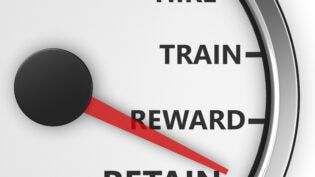
Indeed, analysis of a Gallup workplace survey, found in a 2013 Forbes article, identifies that 18% of American workers are “actively disengaged” from their employer. While this sounds like both a low figure, and an un-alarming description, the cost is very real. The article continues to add that “actively disengaged” employees are “emotionally disconnected from their workplaces and less likely to be productive,” adding that the cost of said unproductiveness is between $450 and $550 million annually, to US businesses alone.
This figure is staggering, and it should be clear that, while the cost to big businesses is going to be high, the cost of one unmotivated employee to a small firm could actually be graver, considering the higher percentage of your company’s employees that they represent. The negativity and non-productivity will spread faster, and the losses will be more keenly felt. Action needs to be taken, and in this article we’ll share some tips for boosting productivity in a small business.
Promote freedom and comfort…
Productivity and employee goodwill can both be enhanced in your small business by making the environment more flexible. You will have cherry-picked your employees for their enthusiasm and ability, so giving them the space both physically and creatively to maximise these qualities will be an absolute boon to your small business.
One of the more popular trends in modern businesses is the idea of being able to work from home, allowing employees to find their muse and remain within their own headspace to help reach your companies goals. Many businesses utilize the office as a meeting place, used mainly for collaboration and meetings.
Another tool used to positive effect by small businesses around the country is to make the office a more creative, relaxed environment. Well stocked break rooms or leisure areas have been making appearances in many offices, allowing employees to relax in between assignments, let off steam, or celebrate victories. Pool tables, games consoles, or even just some comfortable seating and a pleasant coffee table could help you and your employees to relax, and therefore maintain focus while working.
… While monitoring progress and setting achievable goals
No matter what your company’s area, or the size and nature of your present business goals, it’s a good move to make your targets as frequent and easy to achieve as possible. When compared to a single, large business goal (such as ‘’reach sales of $200,000 a year” or ‘’Achieve 1 million site visits this year”), a series of smaller, focussed targets, all leading to the overall final goal, are a much better option.
A series of regular, achievable goals provide your employees with frequent milestones and successes, while also providing a better overview of the project’s many components. At the same time, this approach also allows you to monitor the progress of individual employees, and compensate if certain areas of your business are falling below expected performance levels. In essence, this approach means that progress is easier to measure, and far more keenly felt.
A number of software packages allow for businesses to monitor such targets and schedules; one of the better, free options is 7Geese. The secret to packages such as 7Geese is simplicity, you just input the objectives that your company as a whole needs to achieve, then also add objectives for individual employees. Each objective is made up of a selection of “key results,” the completion of which incrementally increases the level of progress on the overarching objective. In this way, employees at all levels of the company can see their small success building into larger objectives, which in turn build into overall company objectives.
A more comprehensive, commercial alternative is Casewise Synergy, which essentially builds on the functionality of free applications like 7Geese, allowing for the integration of databases and alternative applications, while also providing the facility for planning and simulation. The aim of Casewise Synergy is to allow for maximum customisation and integration of processes and targets, while also providing in depth analytical and management tools.
From the perspective of a small business manager, a system involving a series of small, measurable targets minimises the amount that a manager needs to micromanage, as employee progress and work-streams can be monitored remotely. Once targets have been set, a manager or team leader can monitor progress, only getting involved when a stall in progress demands it. In this way both managers and employees in a small business can be kept happy!
 Author: Nick Bush has a wide range of marketing experience across a diverse array of fields, from medical technology to property. Currently residing in his adoptive city of Portsmouth in the UK, Nick can be reached at nbush@vldigital.co.uk.
Author: Nick Bush has a wide range of marketing experience across a diverse array of fields, from medical technology to property. Currently residing in his adoptive city of Portsmouth in the UK, Nick can be reached at nbush@vldigital.co.uk.
3860 Views












